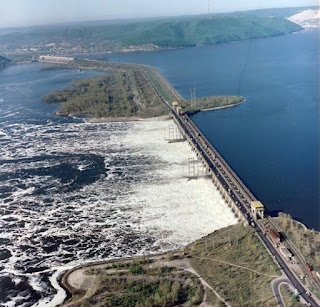The Zhiguli Hydroelectric Station, formerly known as Kuybyshev Hydroelectric Station (Kuybyshev GES) is a large dam and hydroelectric station on the Volga River, located near Zhigulyovsk and Tolyatti in Samara Oblast of Russia. It is the sixth stage of the Volga-Kama Cascade of dams, and the second of them by installed power.
Construction started in 1950 and was completed in 1957. The complex consists of earth-fill dam, 2800 m long, 750 m wide and 52 m high, concrete spillway dam, 980 m long, power plant house, 700 m long, and two-lane navigable locks. Installed power is 2,488 MW, average annual production is 11,700 GWh. The power house has 20 generator units with Kaplan turbines, 4 of 120 MW and 16 of 125.5 MW at 22.5 m head. The dam forms Kuybyshev Reservoir.
The station covers peak loads and maintains frequency stability in the unified power system of Russia (UES), controls flood and maintains navigable waterway. Lower hydroelectric stations are utilised more effectively because of seasonal and over-year regulation provided by the dam. Energy produced by station is transferred by four 500 KV lines - two of them to UES of central Russia and two to UES of the Urals and the Middle Volga.
In July 1955 the first steamer vessel passed through the lower locks. The main stream of the Volga was shut off in November of that year, and the first turbine was put under load on 29 December 1955. In less than a year, by October 1956, 1000 gigawatthours of electric energy was produced. In 1956, 12 turbines were put under load and the next 7 in 1957. On 10 August 1958, the station was renamed after Vladimir Lenin. In May 1959 all constructions were finished. More details
The station covers peak loads and maintains frequency stability in the unified power system of Russia (UES), controls flood and maintains navigable waterway. Lower hydroelectric stations are utilised more effectively because of seasonal and over-year regulation provided by the dam. Energy produced by station is transferred by four 500 KV lines - two of them to UES of central Russia and two to UES of the Urals and the Middle Volga.
In July 1955 the first steamer vessel passed through the lower locks. The main stream of the Volga was shut off in November of that year, and the first turbine was put under load on 29 December 1955. In less than a year, by October 1956, 1000 gigawatthours of electric energy was produced. In 1956, 12 turbines were put under load and the next 7 in 1957. On 10 August 1958, the station was renamed after Vladimir Lenin. In May 1959 all constructions were finished. More details
